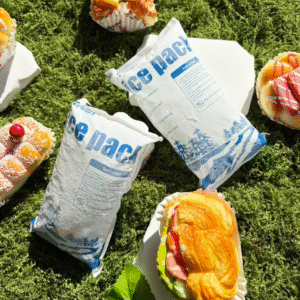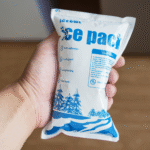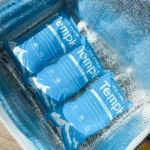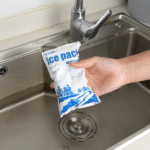Headspace ideal em um saco de gelo seco: 2025 Guia
O headspace ideal em um ba de gelo secog é o volume livre que mantém a ventilação de CO₂ segura e sua carga útil fria. Seu alvo não é apenas um número; é uma configuração que evita o aumento de pressão e mantém temperaturas uniformes. Como ponto de partida, muitos pacotes terrestres validam 15–25% de espaço livre por volume, mas desabafar supera o headspace em todas as pistas, especialmente ar.
-
Como o headspace ideal em um saco de gelo seco afeta a segurança e a uniformidade de temperatura em remessas reais.
-
Qual porcentagem usar como linha de base e quando priorizar a ventilação em vez do volume.
-
Como calcular a evolução de CO₂ na primeira hora para que o caminho de ventilação nunca engasgue.
-
Quais estilos de bolsa mudam o headspace que você precisa (válvula, perfurado, dobrar e prender).
-
O que 2025 tendências de embalagens significam validação, sensores, e aberturas de ventilação mais inteligentes.
Qual é o espaço livre ideal em um saco de gelo seco – e por que isso é importante?
Resposta curta: O headspace ideal em um saco de gelo seco há volume livre suficiente para manter o caminho de ventilação desobstruído enquanto o gás CO₂ escapa continuamente. Mandato dos reguladores ventilado, não hermético pacotes; headspace atende a esse requisito, evitando o inchaço e o resfriamento irregular. Para muitos remetentes isolados, 15–25% de espaço livre equilibra segurança e eficiência, mas as remessas aéreas devem primeiro testar a ventilação.
Visão mais longa: O gelo seco se expande dramaticamente à medida que sublima. Aproximadamente 1 lb rende ~8,8 pés³ de CO₂; 1 kg rende ~500–541 L. Se as aberturas estiverem bloqueadas, a pressão aumenta e pode deformar os revestimentos, comprometer perfis de temperatura, ou violar verificações de conformidade. Use headspace para proteger a rota de ventilação, não para substituí-lo.
Como o headspace ideal em um saco de gelo seco oferece ventilação segura
A ventilação controla o risco; headspace permite ventilação. Uma bolsa com válvula unidirecional pode funcionar com uma folga modesta porque a válvula é a saída projetada. Forros perfurados precisam folga extra no topo então os buracos ficam acima do leito de pellets. Os sacos dobráveis e apertados requerem pescoços espaçosos e deve nunca ser selado a quente. Em todos os estilos, dimensione o headspace para que o gelo nunca obstrua a zona de ventilação.
| Cenário de envio | Headspace da linha de base | Método de ventilação preferido | O que isso significa para você |
|---|---|---|---|
| Chão (alimentos congelados, 10–30 litros) | 15–20% | Forro perfurado com folga | Fluxo de ar estável; baixo risco de ruptura; POP simples. |
| Biopharma (pistas validadas) | 20–25% | Saco de válvula; válvula exposta | Protege frascos, apoia auditorias, tempos de espera mais longos. |
| Carga aérea (qualquer massa) | Funcional (vent primeiro) | Qualquer caminho não hermético | A conformidade requer ventilação visível; % é secundário. |
Dicas práticas que você pode aplicar hoje
-
Frete aéreo: Mostrar um caminho de ventilação visível; nunca sele a quente o poli simples ao redor do gelo seco. Deixar 3–5cm folga perto das aberturas de ventilação.
-
Forros perfurados: Pelotas agitadas, mantenha buracos acima da cama, e evite colar sobre perfurações.
-
Sacos de válvula: Corte uma pequena janela no invólucro para que a válvula respire; não enterre sob paredes de espuma.
Caso do mundo real: Uma equipe de kit de refeição eliminou o abaulamento da caixa trocando um revestimento liso por um saco valvulado e deixando a válvula exposta – sem alteração na massa de gelo, grande melhoria nas verificações de aceitação.
Como você calcula o headspace ideal em um saco de gelo seco?
Ideia central: Combine um linha de base percentual com um verificação de gás na primeira hora. Muitas pistas terrestres validadas funcionam em 15–25% de espaço livre. Em seguida, verifique se o caminho de ventilação pode lidar com a evolução inicial de CO₂ sem inflar. Para planejar, assumir 1–2% da massa de gelo seco sublima por hora em condições ambientes dentro de transportadores isolados.
Passo a passo:
-
Espaço livre de cálculo:
Headspace% = (Container – Product – Ice) ÷ Container × 100%
Alvo 15–25% como ponto de partida para pistas terrestres. -
Estimar CO₂ na primeira hora:
CO₂_first_hour (ft³) ≈ Ice_lb × Rate_per_hour × 8.8
Usar 1–2%/h para Taxa_por_hora. Mantenha as aberturas de ventilação desobstruídas para esse volume. -
Ventilação à prova: Aperte e teste o revestimento carregado; se inflar, reduzir preenchimento, adicionar folga, ou mude para uma bolsa valvulada.
| Volume do contêiner | Exemplo de headspace (20%) | Carga típica de gelo seco | Por que isso ajuda você |
|---|---|---|---|
| 10 L | 2.0 L | 1–2kg | Reduz picos de pressão; fluxo de ar estável. |
| 20 L | 4.0 L | 3–4kg | Suporta resfriamento uniforme em toda a carga útil. |
| 30 L | 6.0 L | 5–6kg | Buffer para sublimação precoce; menos pontos quentes. |
Adicionar “mais” headspace sempre melhora a segurança?
Não. O headspace ideal em um saco de gelo seco evita a obstrução da ventilação, mas a ventilação faz o trabalho de segurança. Muito vazio pode acelerar a sublimação e reduzir a duração. Tamanho para uma rota de ventilação clara, verifique com um registrador, e sintonizar por faixa.
Qual estilo de bolsa altera o espaço livre ideal em uma bolsa de gelo seco?
Saco de válvula (forro ventilado): Headspace modesto é bom porque o válvula é a saída. Mantenha a válvula visível; não cole por cima.
Forro perfurado: Usar headspace moderado então as perfurações ficam acima Pellets. Evite comprimir a zona do buraco com calços ou ajustes de espuma apertados.
Dobrar e prender poli: Requer pescoços espaçosos e nunca selar a quente; escolha pelo menos uma bolsa 1.5× o volume de gelo a granel para evitar que a dobra fique obstruída.
Observação: “Bolsas de gelo seco de 24 células” são folhas de polímero que congela perto 0 °C. Eles não são CO₂ sólidos e não exigem rótulos UN1845 quando usados sozinhos. Use-os para pistas refrigeradas ou pacotes híbridos; eles ocupam espaço que reduz o headspace, então planeje o volume de acordo.
2025 regras de conformidade que moldam o headspace ideal em um saco de gelo seco
A ventilação não é negociável: As regras aéreas exigem pacotes não herméticos e liberação contínua de CO₂. As operadoras alertam explicitamente: não coloque gelo seco em sacos plásticos lacrados. Limites de passageiros (~2,5kg) e os limites de CO₂ no local de trabalho também se aplicam. Planeje o headspace para preservar o caminho de ventilação e passar nas verificações de aceitação.
Lista de verificação rápida
-
Marcar e documentar: UN1845 + peso líquido ao enviar CO₂ sólido.
-
Mantenha uma tampa vazia: Preservar um pequeno vazio superior para que o gás suba e saia livremente.
-
Validar: Os traços do registrador devem mostrar pressão estável e gradientes ≤ ±2 °C na carga útil.
2025 tendências: espaço livre mais inteligente, aberturas de ventilação mais inteligentes
Visão geral da tendência: As equipes estão adotando aberturas reguladas por pressão, Modelos térmicos de IA, e cultura de validação que trata o headspace como um protetor de ventilação funcional em vez de uma percentagem fixa. Espere mais revestimentos de válvula, telemetria de CO₂ em tempo real, e modelos de embalagem que variam por faixa e estação.
Último progresso em um olhar
-
Válvulas inteligentes reguladas por pressão: Alívio automático sob pontas; reduzir o balonismo do forro.
-
3Geometrias de isolamento impressas em D: Modele o headspace para orientar caminhos de gás.
-
Pacotes híbridos: Folhas de polímero estabilizam o produto, pequena carga de CO₂ estende a retenção.
Insight de mercado: Os provedores relatam taxas de aprovação mais altas quando os SOPs mostram explicitamente onde a ventilação fica e quanta folga protege. Muitas pistas padronizam 20–25% para biofarmacêutica e 15–20% para alimentos congelados, em seguida, sintonize por ambiente.
Perguntas frequentes
Q1: Existe uma porcentagem universal para o espaço livre ideal em um saco de gelo seco?
Não. Usar 15–25% como linha de base da pista terrestre, mas regulamentos exigem ventilação, não é um fixo %. Dimensione o headspace para manter o caminho de ventilação aberto.
Q2: Posso selar meu revestimento a quente e confiar apenas no headspace?
Não. Sacos de polietileno simples devem não Seja hermético. Use uma bolsa valvulada ou fecho dobrável que respire.
Q3: Quanto gás aparece no início do trânsito?
Planejar 1–2%/h sublimação inicialmente; 1 libra ≈ 8.8 pés³ CO₂ total. Confirme se o caminho de ventilação suporta o volume da primeira hora.
Q4: As “bolsas de gelo seco” de polímero mudam as necessidades de espaço livre?
Sim. Eles ocupam volume e reduzem o headspace, mas não criam CO₂. Recalcular o volume livre ao misturar com CO₂ sólido.
Q5: O que há de diferente para carga aérea?
As rotas aéreas priorizam ventilação visível e adequado UN1845 Marcas. Headspace é “funcional”: tudo o que preserva a liberação contínua de gás.
Resumo & Recomendações
O headspace ideal em um saco de gelo seco é a folga que protege um caminho de ventilação claro enquanto fornece resfriamento uniforme. Comece em 15–25% para pistas terrestres, então verifique com um verificação de CO₂ na primeira hora e um teste de compressão. Para o ar, liderar com ventilação de conformidade e seleção de estilo de bolsa. Valide sazonalmente e ajuste para o contêiner, carregar, e ambiente.
Etapas de ação:
-
Calcule o headspace e o gás da primeira hora.
-
Escolha o estilo de bolsa certo e exponha as aberturas de ventilação.
-
Pressão e temperatura validadas pelo registrador.
-
Padronize os POPs por faixa e temporada.
-
Documentar UN1845 e treinar equipes sobre fechamentos de ventilação.
Sobre Tempk
Nós projetamos pacotes de cadeia de frio validados que equilibram a segurança, conformidade, e custo. Nossos engenheiros otimizam forros ventilados, POPs de saco valvulado, e Calculadoras de CO₂ dimensionar o headspace ideal em um saco de gelo seco para suas pistas. Os clientes normalmente reduzem as reclamações de chegadas quentes e o retrabalho em dois dígitos após um ciclo sazonal.
Chamado à ação: Precisa de um plano específico para a pista? Agende uma avaliação de 20 minutos e obtenha um SOP pronto para publicar com headspace, ventilação, e critérios de registro adaptados às suas rotas.
























